Exploring Ethical Considerations in Sustainable Energy Research
VerifiedAdded on 2020/05/16
|23
|3748
|160
AI Summary
This research proposal investigates the ethical implications and considerations involved in applying mixed methodologies—combining qualitative and quantitative approaches—in sustainable energy research. The focus is on how these methodologies can be aligned with the achievement of Sustainable Development Goals (SDGs), ensuring responsible, inclusive, and effective policy-making. By addressing potential ethical dilemmas such as data privacy, informed consent, and community impact, this study aims to establish a framework that guides researchers in conducting ethically sound energy research. The proposal outlines the significance of ethics in sustainable development studies, reviews relevant literature on mixed methodologies, and proposes a structured approach for integrating ethical considerations into research practices. Through qualitative interviews, case studies, and quantitative analysis, the proposed research seeks to contribute valuable insights to both academic discourse and practical applications within sustainable energy initiatives.

Running Head: Energy in Sustainable Development Goals
Assignment B: Energy in Sustainable Development Goals
Assignment B: Energy in Sustainable Development Goals
Paraphrase This Document
Need a fresh take? Get an instant paraphrase of this document with our AI Paraphraser
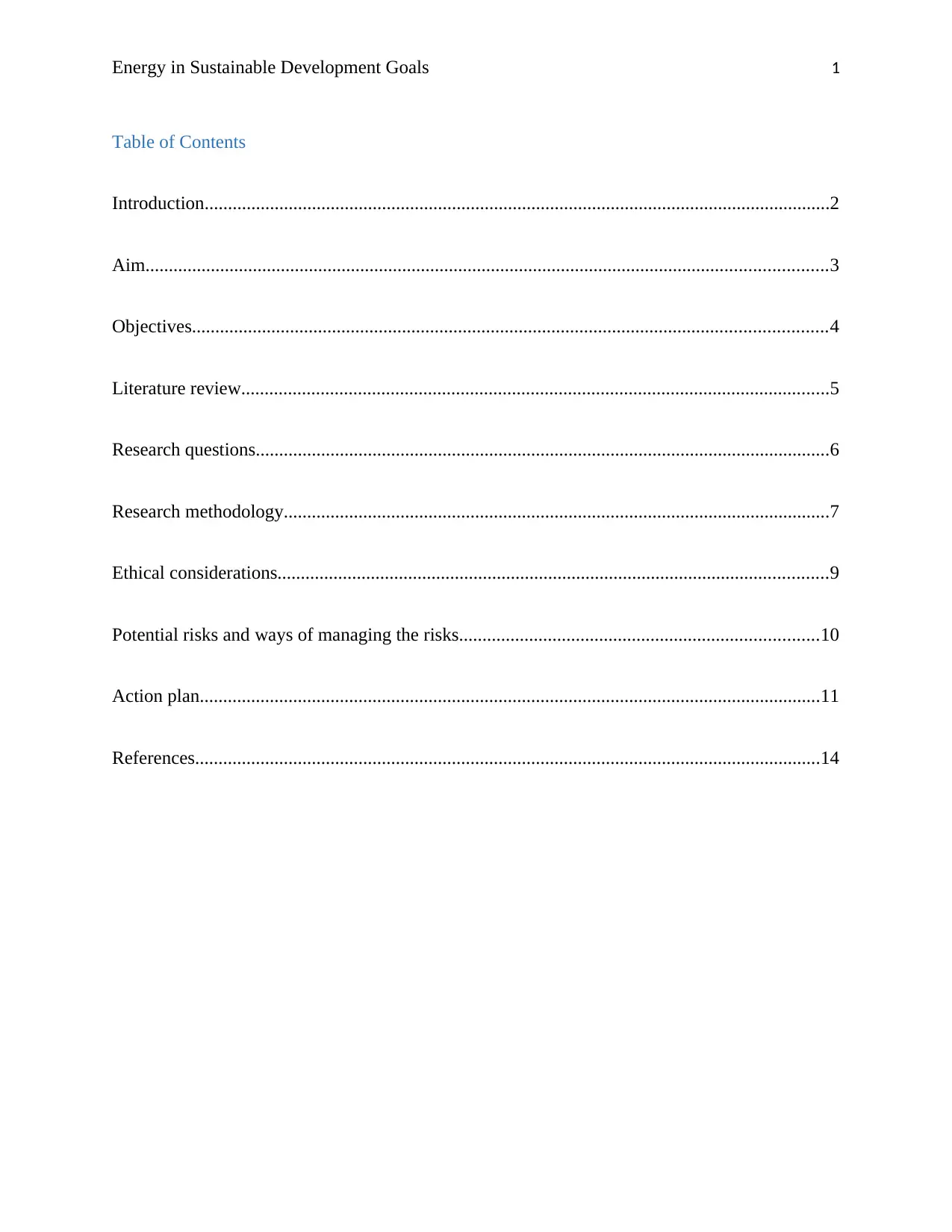
Energy in Sustainable Development Goals 1
Table of Contents
Introduction......................................................................................................................................2
Aim..................................................................................................................................................3
Objectives........................................................................................................................................4
Literature review..............................................................................................................................5
Research questions...........................................................................................................................6
Research methodology.....................................................................................................................7
Ethical considerations......................................................................................................................9
Potential risks and ways of managing the risks.............................................................................10
Action plan.....................................................................................................................................11
References......................................................................................................................................14
Table of Contents
Introduction......................................................................................................................................2
Aim..................................................................................................................................................3
Objectives........................................................................................................................................4
Literature review..............................................................................................................................5
Research questions...........................................................................................................................6
Research methodology.....................................................................................................................7
Ethical considerations......................................................................................................................9
Potential risks and ways of managing the risks.............................................................................10
Action plan.....................................................................................................................................11
References......................................................................................................................................14

Energy in Sustainable Development Goals 2
Introduction
In the words of Jaramillo-Nieves & Río (2010), energy is the key determinant for every
challenge or opportunity which is being faced by the world in the present scenario. Access to the
energy is an essential element for every aspect of the world whether it is employment, climate,
production of goods or services or security. Sustainable energy acts as an opportunity for the
transformation of the lives, economies, and planet (Goozee, 2017). The focus of every economy
is on preserving the energy resources and increasing the use of renewable energy sources for
enhancing the level of efficiency. Impact of the energy can be seen in every aspect of the world
as energy is the driving force which forms a base for the development of an economy (Sovacool,
2012).
IN EU, the focus is on producing products or services with the use of environment-
friendly energy sources. The need for these energy resources is increasing with a motive to
protect the society, economy, and environment (Sovacool, et. al., 2016). Various steps have been
taken by the government so as to increase the use of renewable resources. These steps include
construction of solar power plants and increasing the use of hydroelectricity (ICTSD, 2014).
These initiatives have resulted in reducing the cost as well as providing an environment-friendly
solution (Wolfram, et. al., 2012). This research program will develop knowledge regarding the
concept of sustainable energy, the role of energy in SGD, issues identified during the
implementation plan and solutions for overcoming these issues.
Introduction
In the words of Jaramillo-Nieves & Río (2010), energy is the key determinant for every
challenge or opportunity which is being faced by the world in the present scenario. Access to the
energy is an essential element for every aspect of the world whether it is employment, climate,
production of goods or services or security. Sustainable energy acts as an opportunity for the
transformation of the lives, economies, and planet (Goozee, 2017). The focus of every economy
is on preserving the energy resources and increasing the use of renewable energy sources for
enhancing the level of efficiency. Impact of the energy can be seen in every aspect of the world
as energy is the driving force which forms a base for the development of an economy (Sovacool,
2012).
IN EU, the focus is on producing products or services with the use of environment-
friendly energy sources. The need for these energy resources is increasing with a motive to
protect the society, economy, and environment (Sovacool, et. al., 2016). Various steps have been
taken by the government so as to increase the use of renewable resources. These steps include
construction of solar power plants and increasing the use of hydroelectricity (ICTSD, 2014).
These initiatives have resulted in reducing the cost as well as providing an environment-friendly
solution (Wolfram, et. al., 2012). This research program will develop knowledge regarding the
concept of sustainable energy, the role of energy in SGD, issues identified during the
implementation plan and solutions for overcoming these issues.
⊘ This is a preview!⊘
Do you want full access?
Subscribe today to unlock all pages.

Trusted by 1+ million students worldwide

Energy in Sustainable Development Goals 3
Aim
This research program has been initiated with the motive to analyze the importance of the energy
in attaining sustainable environment. For the overall development of the society, sustainable
environment is required. This research will focus on developing knowledge regarding the
balance which has to be established between the renewable and non-renewable resources for
maintaining sustainable environment and development. The focus of the research will be on
identifying the issues affecting the process of sustainable development and solutions for
overcoming these issues. Different issues are affecting the process of sustainable development
which will be discussed in this research program.
Aim
This research program has been initiated with the motive to analyze the importance of the energy
in attaining sustainable environment. For the overall development of the society, sustainable
environment is required. This research will focus on developing knowledge regarding the
balance which has to be established between the renewable and non-renewable resources for
maintaining sustainable environment and development. The focus of the research will be on
identifying the issues affecting the process of sustainable development and solutions for
overcoming these issues. Different issues are affecting the process of sustainable development
which will be discussed in this research program.
Paraphrase This Document
Need a fresh take? Get an instant paraphrase of this document with our AI Paraphraser
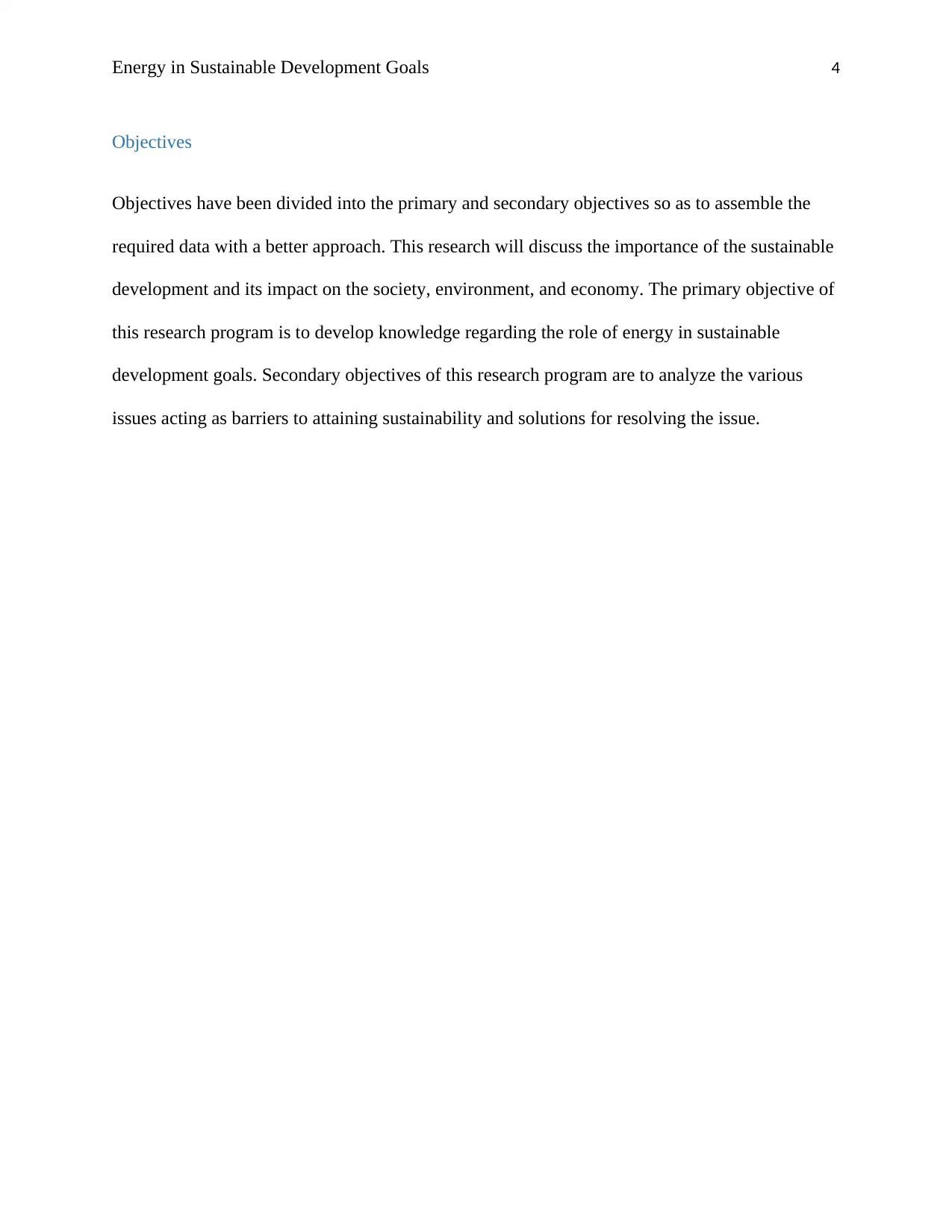
Energy in Sustainable Development Goals 4
Objectives
Objectives have been divided into the primary and secondary objectives so as to assemble the
required data with a better approach. This research will discuss the importance of the sustainable
development and its impact on the society, environment, and economy. The primary objective of
this research program is to develop knowledge regarding the role of energy in sustainable
development goals. Secondary objectives of this research program are to analyze the various
issues acting as barriers to attaining sustainability and solutions for resolving the issue.
Objectives
Objectives have been divided into the primary and secondary objectives so as to assemble the
required data with a better approach. This research will discuss the importance of the sustainable
development and its impact on the society, environment, and economy. The primary objective of
this research program is to develop knowledge regarding the role of energy in sustainable
development goals. Secondary objectives of this research program are to analyze the various
issues acting as barriers to attaining sustainability and solutions for resolving the issue.
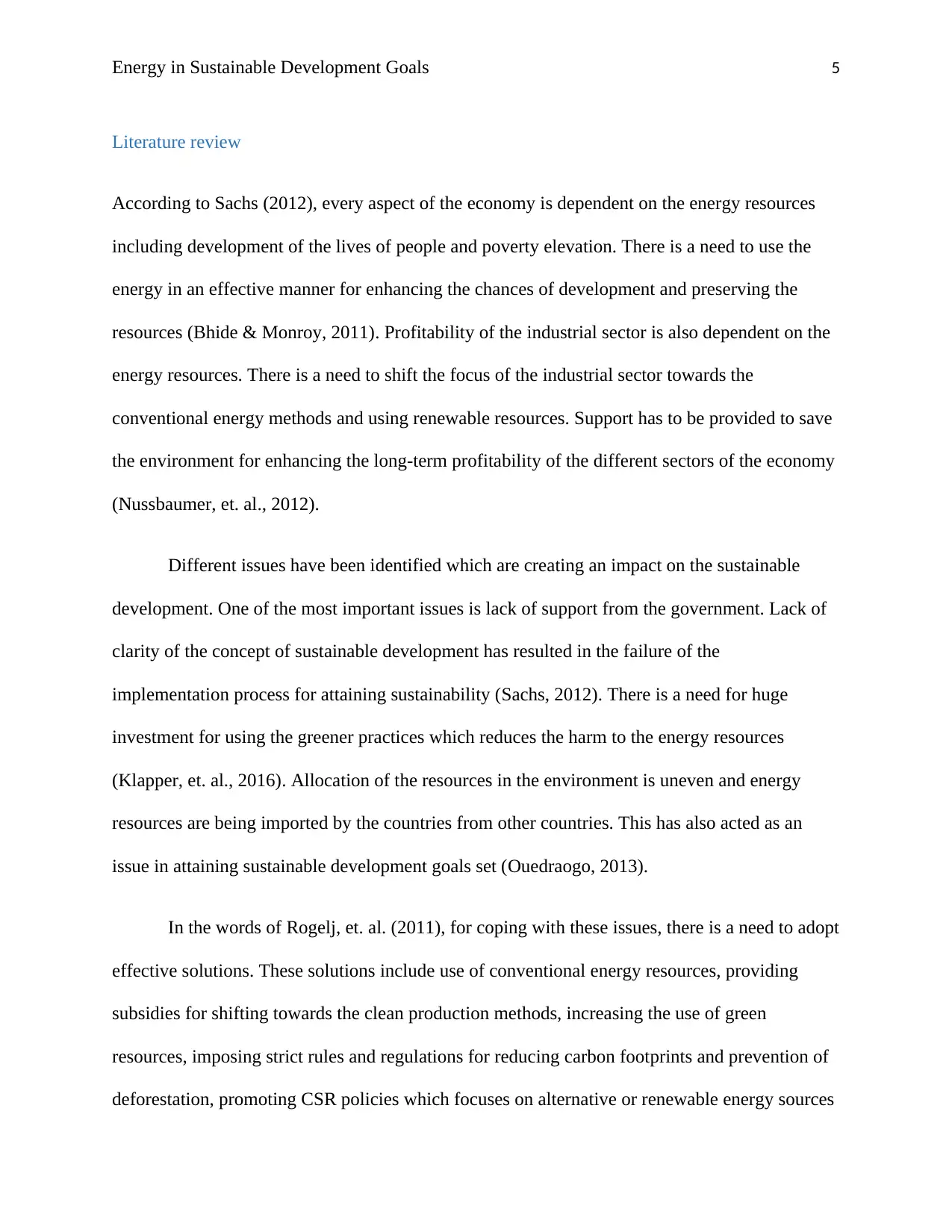
Energy in Sustainable Development Goals 5
Literature review
According to Sachs (2012), every aspect of the economy is dependent on the energy resources
including development of the lives of people and poverty elevation. There is a need to use the
energy in an effective manner for enhancing the chances of development and preserving the
resources (Bhide & Monroy, 2011). Profitability of the industrial sector is also dependent on the
energy resources. There is a need to shift the focus of the industrial sector towards the
conventional energy methods and using renewable resources. Support has to be provided to save
the environment for enhancing the long-term profitability of the different sectors of the economy
(Nussbaumer, et. al., 2012).
Different issues have been identified which are creating an impact on the sustainable
development. One of the most important issues is lack of support from the government. Lack of
clarity of the concept of sustainable development has resulted in the failure of the
implementation process for attaining sustainability (Sachs, 2012). There is a need for huge
investment for using the greener practices which reduces the harm to the energy resources
(Klapper, et. al., 2016). Allocation of the resources in the environment is uneven and energy
resources are being imported by the countries from other countries. This has also acted as an
issue in attaining sustainable development goals set (Ouedraogo, 2013).
In the words of Rogelj, et. al. (2011), for coping with these issues, there is a need to adopt
effective solutions. These solutions include use of conventional energy resources, providing
subsidies for shifting towards the clean production methods, increasing the use of green
resources, imposing strict rules and regulations for reducing carbon footprints and prevention of
deforestation, promoting CSR policies which focuses on alternative or renewable energy sources
Literature review
According to Sachs (2012), every aspect of the economy is dependent on the energy resources
including development of the lives of people and poverty elevation. There is a need to use the
energy in an effective manner for enhancing the chances of development and preserving the
resources (Bhide & Monroy, 2011). Profitability of the industrial sector is also dependent on the
energy resources. There is a need to shift the focus of the industrial sector towards the
conventional energy methods and using renewable resources. Support has to be provided to save
the environment for enhancing the long-term profitability of the different sectors of the economy
(Nussbaumer, et. al., 2012).
Different issues have been identified which are creating an impact on the sustainable
development. One of the most important issues is lack of support from the government. Lack of
clarity of the concept of sustainable development has resulted in the failure of the
implementation process for attaining sustainability (Sachs, 2012). There is a need for huge
investment for using the greener practices which reduces the harm to the energy resources
(Klapper, et. al., 2016). Allocation of the resources in the environment is uneven and energy
resources are being imported by the countries from other countries. This has also acted as an
issue in attaining sustainable development goals set (Ouedraogo, 2013).
In the words of Rogelj, et. al. (2011), for coping with these issues, there is a need to adopt
effective solutions. These solutions include use of conventional energy resources, providing
subsidies for shifting towards the clean production methods, increasing the use of green
resources, imposing strict rules and regulations for reducing carbon footprints and prevention of
deforestation, promoting CSR policies which focuses on alternative or renewable energy sources
⊘ This is a preview!⊘
Do you want full access?
Subscribe today to unlock all pages.

Trusted by 1+ million students worldwide

Energy in Sustainable Development Goals 6
and privatization of the power sector for reducing the cost. Different industries operating in the
economy can use green resources or renewable resources so as to execute their operations
(Nilsson, et. al., 2012).
and privatization of the power sector for reducing the cost. Different industries operating in the
economy can use green resources or renewable resources so as to execute their operations
(Nilsson, et. al., 2012).
Paraphrase This Document
Need a fresh take? Get an instant paraphrase of this document with our AI Paraphraser
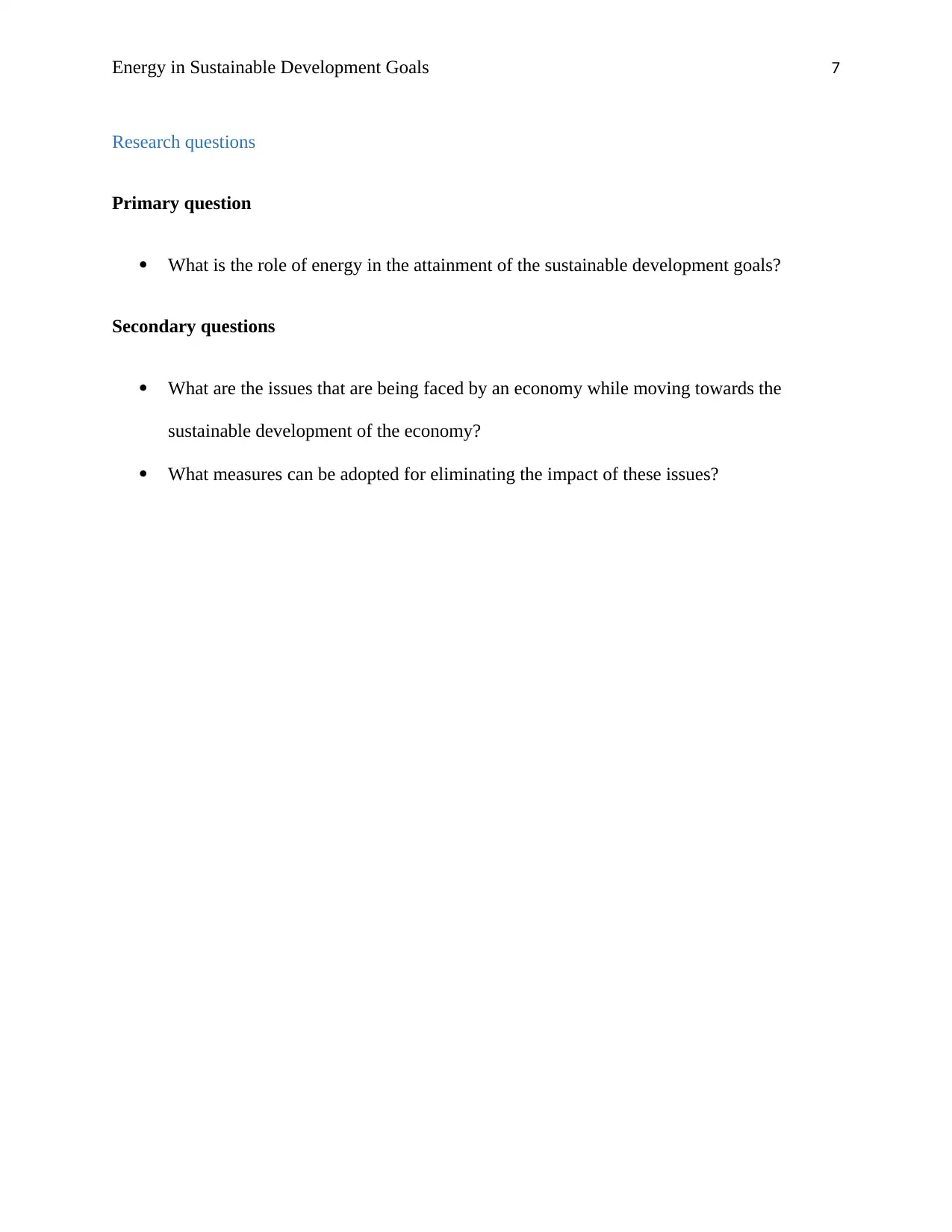
Energy in Sustainable Development Goals 7
Research questions
Primary question
What is the role of energy in the attainment of the sustainable development goals?
Secondary questions
What are the issues that are being faced by an economy while moving towards the
sustainable development of the economy?
What measures can be adopted for eliminating the impact of these issues?
Research questions
Primary question
What is the role of energy in the attainment of the sustainable development goals?
Secondary questions
What are the issues that are being faced by an economy while moving towards the
sustainable development of the economy?
What measures can be adopted for eliminating the impact of these issues?
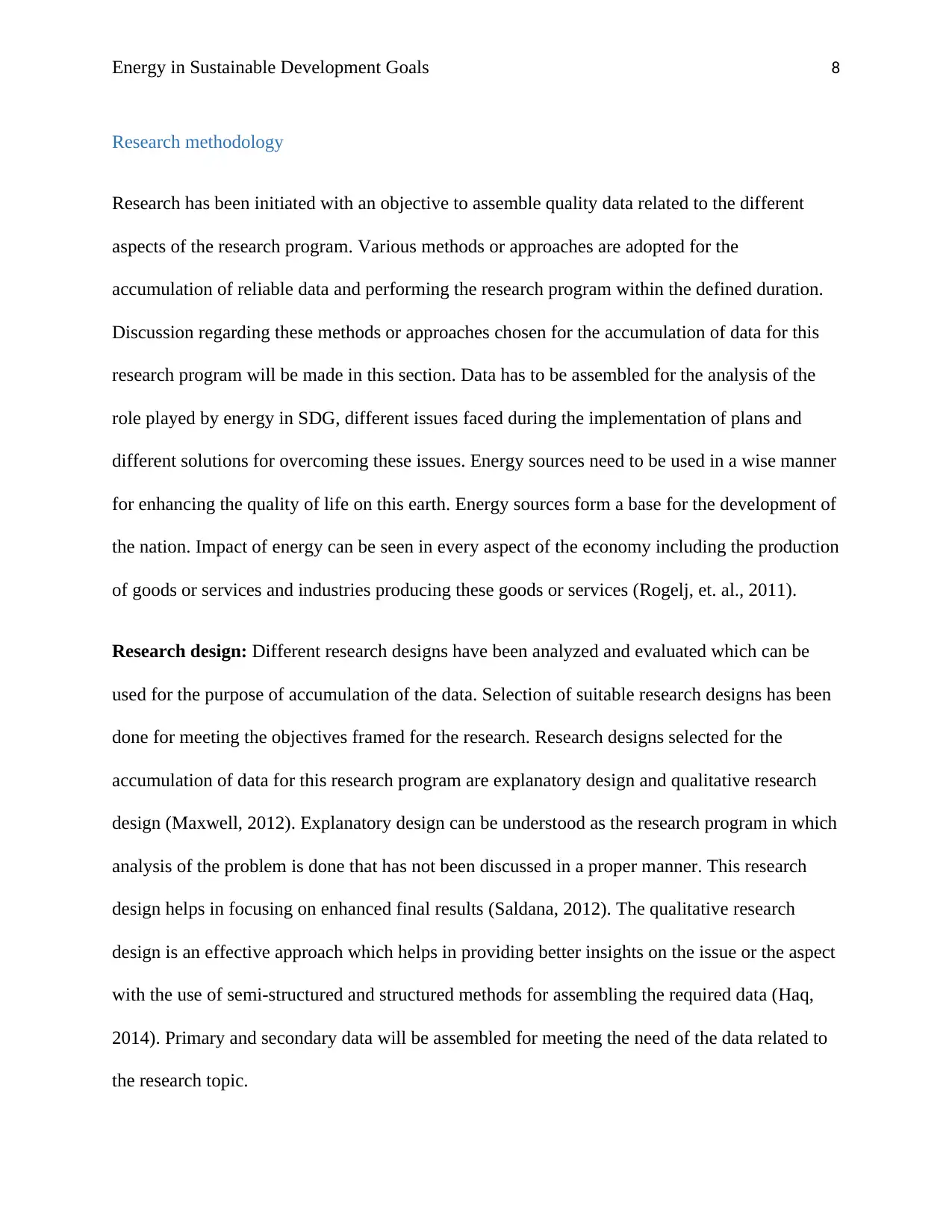
Energy in Sustainable Development Goals 8
Research methodology
Research has been initiated with an objective to assemble quality data related to the different
aspects of the research program. Various methods or approaches are adopted for the
accumulation of reliable data and performing the research program within the defined duration.
Discussion regarding these methods or approaches chosen for the accumulation of data for this
research program will be made in this section. Data has to be assembled for the analysis of the
role played by energy in SDG, different issues faced during the implementation of plans and
different solutions for overcoming these issues. Energy sources need to be used in a wise manner
for enhancing the quality of life on this earth. Energy sources form a base for the development of
the nation. Impact of energy can be seen in every aspect of the economy including the production
of goods or services and industries producing these goods or services (Rogelj, et. al., 2011).
Research design: Different research designs have been analyzed and evaluated which can be
used for the purpose of accumulation of the data. Selection of suitable research designs has been
done for meeting the objectives framed for the research. Research designs selected for the
accumulation of data for this research program are explanatory design and qualitative research
design (Maxwell, 2012). Explanatory design can be understood as the research program in which
analysis of the problem is done that has not been discussed in a proper manner. This research
design helps in focusing on enhanced final results (Saldana, 2012). The qualitative research
design is an effective approach which helps in providing better insights on the issue or the aspect
with the use of semi-structured and structured methods for assembling the required data (Haq,
2014). Primary and secondary data will be assembled for meeting the need of the data related to
the research topic.
Research methodology
Research has been initiated with an objective to assemble quality data related to the different
aspects of the research program. Various methods or approaches are adopted for the
accumulation of reliable data and performing the research program within the defined duration.
Discussion regarding these methods or approaches chosen for the accumulation of data for this
research program will be made in this section. Data has to be assembled for the analysis of the
role played by energy in SDG, different issues faced during the implementation of plans and
different solutions for overcoming these issues. Energy sources need to be used in a wise manner
for enhancing the quality of life on this earth. Energy sources form a base for the development of
the nation. Impact of energy can be seen in every aspect of the economy including the production
of goods or services and industries producing these goods or services (Rogelj, et. al., 2011).
Research design: Different research designs have been analyzed and evaluated which can be
used for the purpose of accumulation of the data. Selection of suitable research designs has been
done for meeting the objectives framed for the research. Research designs selected for the
accumulation of data for this research program are explanatory design and qualitative research
design (Maxwell, 2012). Explanatory design can be understood as the research program in which
analysis of the problem is done that has not been discussed in a proper manner. This research
design helps in focusing on enhanced final results (Saldana, 2012). The qualitative research
design is an effective approach which helps in providing better insights on the issue or the aspect
with the use of semi-structured and structured methods for assembling the required data (Haq,
2014). Primary and secondary data will be assembled for meeting the need of the data related to
the research topic.
⊘ This is a preview!⊘
Do you want full access?
Subscribe today to unlock all pages.

Trusted by 1+ million students worldwide
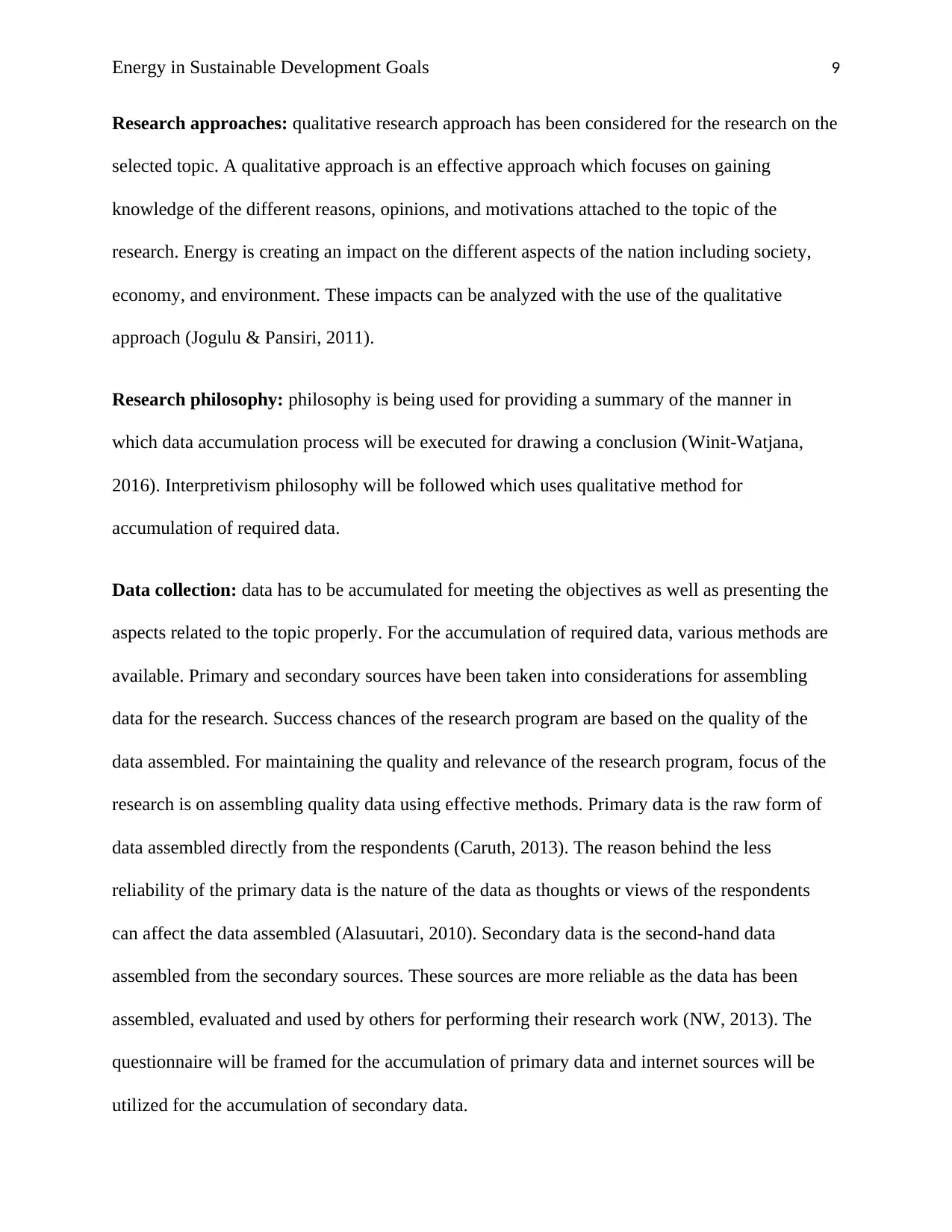
Energy in Sustainable Development Goals 9
Research approaches: qualitative research approach has been considered for the research on the
selected topic. A qualitative approach is an effective approach which focuses on gaining
knowledge of the different reasons, opinions, and motivations attached to the topic of the
research. Energy is creating an impact on the different aspects of the nation including society,
economy, and environment. These impacts can be analyzed with the use of the qualitative
approach (Jogulu & Pansiri, 2011).
Research philosophy: philosophy is being used for providing a summary of the manner in
which data accumulation process will be executed for drawing a conclusion (Winit-Watjana,
2016). Interpretivism philosophy will be followed which uses qualitative method for
accumulation of required data.
Data collection: data has to be accumulated for meeting the objectives as well as presenting the
aspects related to the topic properly. For the accumulation of required data, various methods are
available. Primary and secondary sources have been taken into considerations for assembling
data for the research. Success chances of the research program are based on the quality of the
data assembled. For maintaining the quality and relevance of the research program, focus of the
research is on assembling quality data using effective methods. Primary data is the raw form of
data assembled directly from the respondents (Caruth, 2013). The reason behind the less
reliability of the primary data is the nature of the data as thoughts or views of the respondents
can affect the data assembled (Alasuutari, 2010). Secondary data is the second-hand data
assembled from the secondary sources. These sources are more reliable as the data has been
assembled, evaluated and used by others for performing their research work (NW, 2013). The
questionnaire will be framed for the accumulation of primary data and internet sources will be
utilized for the accumulation of secondary data.
Research approaches: qualitative research approach has been considered for the research on the
selected topic. A qualitative approach is an effective approach which focuses on gaining
knowledge of the different reasons, opinions, and motivations attached to the topic of the
research. Energy is creating an impact on the different aspects of the nation including society,
economy, and environment. These impacts can be analyzed with the use of the qualitative
approach (Jogulu & Pansiri, 2011).
Research philosophy: philosophy is being used for providing a summary of the manner in
which data accumulation process will be executed for drawing a conclusion (Winit-Watjana,
2016). Interpretivism philosophy will be followed which uses qualitative method for
accumulation of required data.
Data collection: data has to be accumulated for meeting the objectives as well as presenting the
aspects related to the topic properly. For the accumulation of required data, various methods are
available. Primary and secondary sources have been taken into considerations for assembling
data for the research. Success chances of the research program are based on the quality of the
data assembled. For maintaining the quality and relevance of the research program, focus of the
research is on assembling quality data using effective methods. Primary data is the raw form of
data assembled directly from the respondents (Caruth, 2013). The reason behind the less
reliability of the primary data is the nature of the data as thoughts or views of the respondents
can affect the data assembled (Alasuutari, 2010). Secondary data is the second-hand data
assembled from the secondary sources. These sources are more reliable as the data has been
assembled, evaluated and used by others for performing their research work (NW, 2013). The
questionnaire will be framed for the accumulation of primary data and internet sources will be
utilized for the accumulation of secondary data.
Paraphrase This Document
Need a fresh take? Get an instant paraphrase of this document with our AI Paraphraser
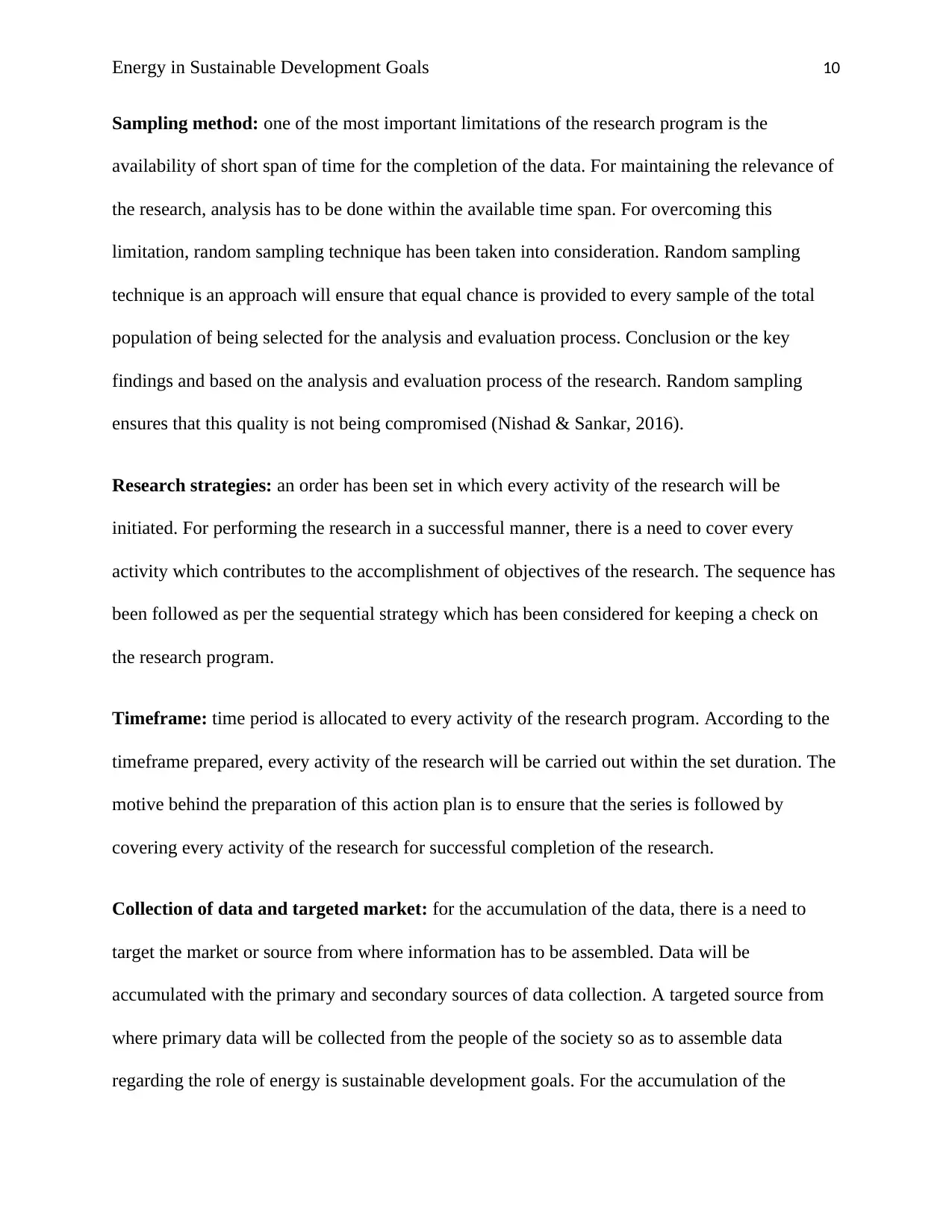
Energy in Sustainable Development Goals 10
Sampling method: one of the most important limitations of the research program is the
availability of short span of time for the completion of the data. For maintaining the relevance of
the research, analysis has to be done within the available time span. For overcoming this
limitation, random sampling technique has been taken into consideration. Random sampling
technique is an approach will ensure that equal chance is provided to every sample of the total
population of being selected for the analysis and evaluation process. Conclusion or the key
findings and based on the analysis and evaluation process of the research. Random sampling
ensures that this quality is not being compromised (Nishad & Sankar, 2016).
Research strategies: an order has been set in which every activity of the research will be
initiated. For performing the research in a successful manner, there is a need to cover every
activity which contributes to the accomplishment of objectives of the research. The sequence has
been followed as per the sequential strategy which has been considered for keeping a check on
the research program.
Timeframe: time period is allocated to every activity of the research program. According to the
timeframe prepared, every activity of the research will be carried out within the set duration. The
motive behind the preparation of this action plan is to ensure that the series is followed by
covering every activity of the research for successful completion of the research.
Collection of data and targeted market: for the accumulation of the data, there is a need to
target the market or source from where information has to be assembled. Data will be
accumulated with the primary and secondary sources of data collection. A targeted source from
where primary data will be collected from the people of the society so as to assemble data
regarding the role of energy is sustainable development goals. For the accumulation of the
Sampling method: one of the most important limitations of the research program is the
availability of short span of time for the completion of the data. For maintaining the relevance of
the research, analysis has to be done within the available time span. For overcoming this
limitation, random sampling technique has been taken into consideration. Random sampling
technique is an approach will ensure that equal chance is provided to every sample of the total
population of being selected for the analysis and evaluation process. Conclusion or the key
findings and based on the analysis and evaluation process of the research. Random sampling
ensures that this quality is not being compromised (Nishad & Sankar, 2016).
Research strategies: an order has been set in which every activity of the research will be
initiated. For performing the research in a successful manner, there is a need to cover every
activity which contributes to the accomplishment of objectives of the research. The sequence has
been followed as per the sequential strategy which has been considered for keeping a check on
the research program.
Timeframe: time period is allocated to every activity of the research program. According to the
timeframe prepared, every activity of the research will be carried out within the set duration. The
motive behind the preparation of this action plan is to ensure that the series is followed by
covering every activity of the research for successful completion of the research.
Collection of data and targeted market: for the accumulation of the data, there is a need to
target the market or source from where information has to be assembled. Data will be
accumulated with the primary and secondary sources of data collection. A targeted source from
where primary data will be collected from the people of the society so as to assemble data
regarding the role of energy is sustainable development goals. For the accumulation of the
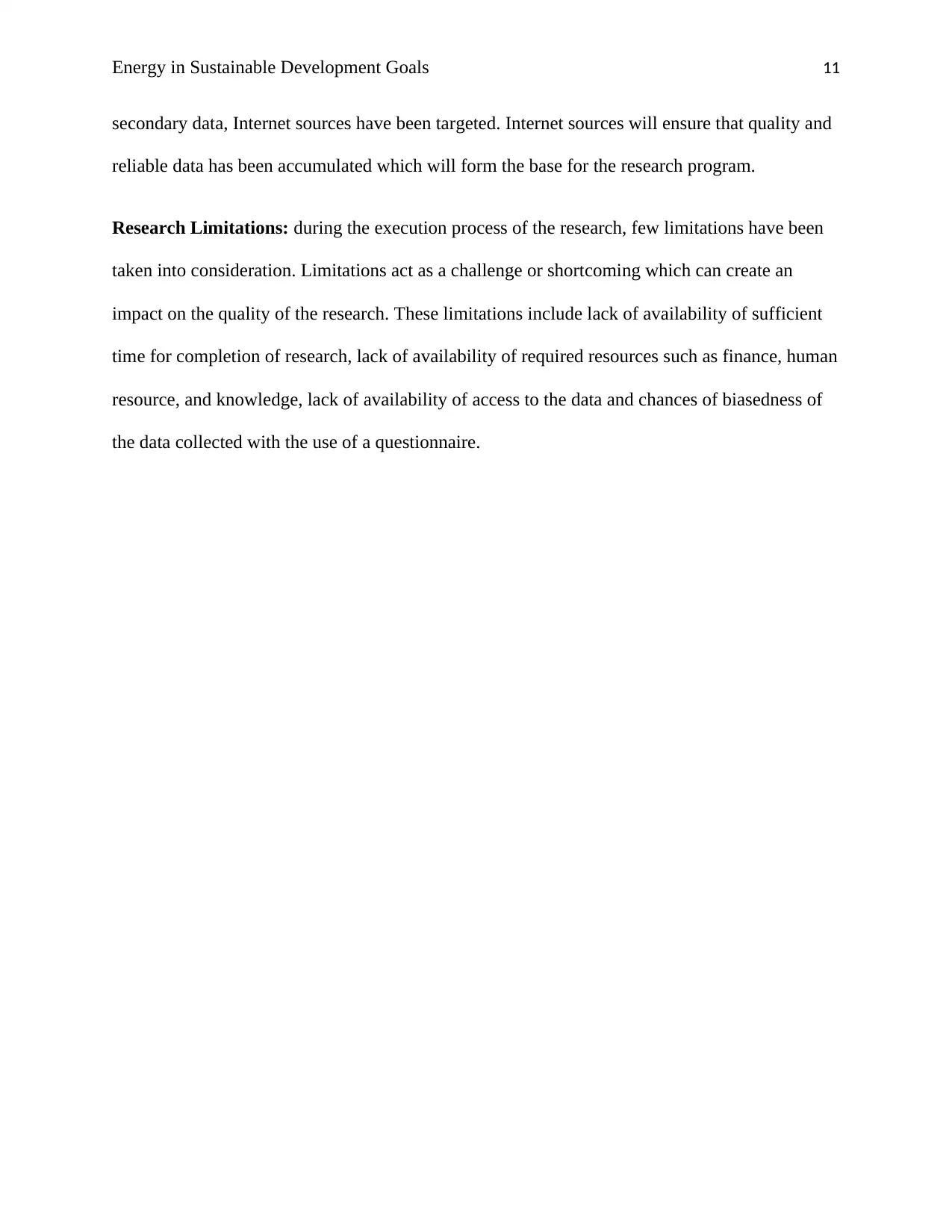
Energy in Sustainable Development Goals 11
secondary data, Internet sources have been targeted. Internet sources will ensure that quality and
reliable data has been accumulated which will form the base for the research program.
Research Limitations: during the execution process of the research, few limitations have been
taken into consideration. Limitations act as a challenge or shortcoming which can create an
impact on the quality of the research. These limitations include lack of availability of sufficient
time for completion of research, lack of availability of required resources such as finance, human
resource, and knowledge, lack of availability of access to the data and chances of biasedness of
the data collected with the use of a questionnaire.
secondary data, Internet sources have been targeted. Internet sources will ensure that quality and
reliable data has been accumulated which will form the base for the research program.
Research Limitations: during the execution process of the research, few limitations have been
taken into consideration. Limitations act as a challenge or shortcoming which can create an
impact on the quality of the research. These limitations include lack of availability of sufficient
time for completion of research, lack of availability of required resources such as finance, human
resource, and knowledge, lack of availability of access to the data and chances of biasedness of
the data collected with the use of a questionnaire.
⊘ This is a preview!⊘
Do you want full access?
Subscribe today to unlock all pages.

Trusted by 1+ million students worldwide
1 out of 23
Related Documents
Your All-in-One AI-Powered Toolkit for Academic Success.
+13062052269
info@desklib.com
Available 24*7 on WhatsApp / Email
![[object Object]](/_next/static/media/star-bottom.7253800d.svg)
Unlock your academic potential
Copyright © 2020–2025 A2Z Services. All Rights Reserved. Developed and managed by ZUCOL.





